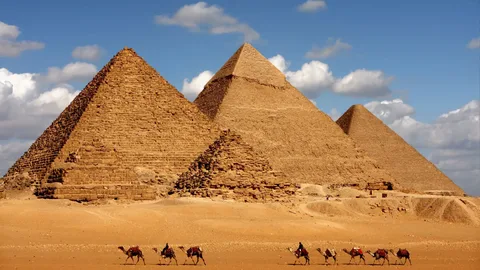History of the Pyramids of Giza – Ancient Wonders Revealed
History of the Pyramids of Giza is a topic that has fascinated historians, archaeologists, and travelers for centuries. These magnificent structures, located on the Giza Plateau near Cairo, Egypt, are not only architectural marvels but also serve as a testament to the ingenuity and vision of ancient Egyptian civilization.
In this article, we delve into the rich history of the Pyramids of Giza, their construction, and the mysteries surrounding them.
Who Built the Pyramids of Giza?
Who built the Pyramids of Giza, and why were they constructed? The history of the Pyramids of Giza reveals that they were built during the Fourth Dynasty of the Old Kingdom, around 2600 to 2500 BCE.
They were commissioned by Pharaohs Khufu, Khafre, and Menkaure as grand tombs to ensure their journey into the afterlife. These pharaohs, considered divine rulers, utilized the pyramids as a connection to the gods.
Discover more about the builders of the pyramids with our Egypt Tours.
For additional insights into ancient Egyptian rulers, visit National Geographic.
How Were the Pyramids of Giza Constructed?
What techniques were used to construct the Pyramids of Giza? The construction of the Pyramids of Giza remains a source of awe and speculation. The history of the Pyramids of Giza suggests that tens of thousands of skilled laborers, not slaves as often depicted, worked tirelessly to create these monumental structures.
They used copper tools to cut limestone blocks, which were then transported on sledges and ramps.
To see the engineering feats of ancient Egypt up close, join our Tours & Excursions from Hurghada.
For modern theories on pyramid construction, explore Smithsonian Magazine.
What Are the Pyramids of Giza?
What makes the Pyramids of Giza unique? The history of the Pyramids of Giza highlights the Giza Pyramid Complex, which consists of three main pyramids:
- The Great Pyramid of Khufu: The largest and most famous, originally standing at 146 meters.
- The Pyramid of Khafre: Known for the Great Sphinx located nearby.
- The Pyramid of Menkaure: The smallest of the three but still impressive.
Each pyramid is surrounded by smaller satellite pyramids, temples, and causeways. Explore this ancient wonder with our Tours & Excursions from El-Gouna.
Why Were the Pyramids Built?
The Pyramids of Giza were built as grand tombs for ancient Egyptian pharaohs, primarily during the Old Kingdom period. They served as monumental resting places to ensure the ruler's journey to the afterlife. The pyramids were designed to symbolize the pharaoh's divine authority and eternal connection to the gods.
These structures were meticulously constructed to protect the mummified bodies and the treasures buried within. The triangular shape of the pyramids is believed to represent the sun's rays, guiding the soul of the deceased to the heavens. Additionally, they reflected the Egyptians' advanced understanding of architecture and their strong belief in life after death.
What Is the History of the Pyramids of Giza?
The history of the Pyramids of Giza dates back to the Fourth Dynasty of ancient Egypt, approximately 2600 to 2500 BCE. These monumental structures were commissioned by Pharaohs Khufu, Khafre, and Menkaure as eternal resting places and symbols of their divine authority. The Great Pyramid of Khufu, the largest, was once the tallest man-made structure in the world for over 3,800 years.
The pyramids served not only as tombs but also as reflections of the Egyptians' deep belief in the afterlife, showcasing their advanced engineering skills and religious devotion.
The History of the Pyramids of Giza and Their Purpose
What was the purpose of the Pyramids of Giza? The history of the Pyramids of Giza reveals that they were designed as eternal resting places for the pharaohs.
They contained burial chambers filled with treasures, hieroglyphs, and artifacts meant to assist the deceased in the afterlife. Their triangular shape symbolized the rays of the sun, guiding the pharaoh’s soul to the heavens.
Experience the spiritual significance of the pyramids with our Nile Cruises.
Learn more about their purpose on Ancient History Encyclopedia.
How Have the Pyramids of Giza Influenced Modern Culture?
What is the cultural impact of the Pyramids of Giza? The history of the Pyramids of Giza demonstrates their influence on countless works of art, literature, and film. They are also central to the study of ancient Egyptian history and architecture. The Great Pyramid, the last surviving wonder of the ancient world, remains a symbol of human achievement and resilience.
Immerse yourself in Egypt’s cultural heritage with our Safaga Shore Excursions.
Conclusion
History of the Pyramids of Giza continues to captivate the world, standing as a testament to the brilliance of ancient Egypt. From their construction to their enduring cultural significance, the history of the Pyramids of Giza remains an essential topic for travelers and scholars alike.
Let Sonnenland Reisen take you on a journey through time. Our expert-guided tours and tailored itineraries ensure you experience the history of the Pyramids of Giza and other Egyptian wonders in the most enriching way.
Contact us today to start planning your adventure!
Frequently Asked Questions (FAQs)
1. Are the Pyramids of Giza open to visitors?
Yes, visitors can explore the pyramids and their surrounding complex. Entry tickets are available for general access and for entering the pyramids themselves.
2. Can you climb the pyramids?
No, climbing the pyramids is prohibited to preserve their structure and ensure visitor safety.
3. What other attractions are near the Pyramids of Giza?
Nearby attractions include the Great Sphinx, the Solar Boat Museum, and the bustling city of Cairo.

 English
English  Deutsch
Deutsch 